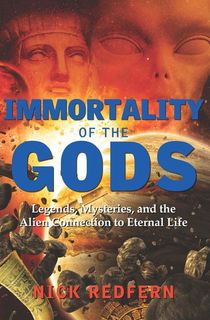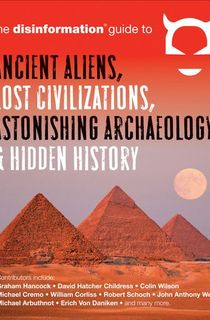“They’re falling out of the skies like flies. Government knows all about it … Chariots of the Gods, man … they practically own South America. I mean, they taught the Incas everything they knew.”
That’s Palmer, played by David Clennon, speaking in John Carpenter’s classic 1982 alien horror movie The Thing, but what he’s espousing is a popular and widely-held pseudoscientific theory that the Earth was visit in prehistory by “ancient astronauts.” It even references one of the more popular books on the subject, Erich von Daniken’s 1968 work, Chariots of the Gods, which was made into a documentary film in 1970 and nominated for an Academy Award.
What is ancient astronaut theory?

Like any widely-held theory of popular pseudoscience, ancient astronaut theory has a number of variations, but they almost all agree about one central “fact”: that extraterrestrial visitors came to Earth in prehistoric times or visited ancient human civilizations. Reporting on the popular History Channel series Ancient Aliens—which is probably the most recognized modern mouthpiece for the theory—Steven Kurutz wrote for The New York Times, “According to the show’s talking heads, extraterrestrials may have had a role not only in the extermination of the dinosaurs, but also in the construction of the Egyptian pyramids.”
Indeed, probably the most central tenet of the vast majority of ancient astronaut beliefs is that these extraterrestrial visitors are responsible for much of the culture, technology, and architecture of most ancient civilizations—especially, it must be said, the non-white ones. As one attendee of AlienCon puts it in that same New York Times piece, “Just because someone says the Egyptians made the temples with ropes and wooden rollers doesn’t make it true. We shouldn’t accept blindly things we’ve been taught by quote-unquote scientists.”
Of course, in addition to claims that ancient aliens helped to build structures such as the pyramids of Egypt or the moai of Easter Island, ancient astronaut theory poses a number of other hypotheses, too, including “that deities from most, if not all, religions are extraterrestrial in origin.” Or, as Peloquin puts it in Clive Barker’s Nightbreed, “God’s an astronaut.”

Immortality of the Gods
Where does ancient astronaut theory originate?
One of the first people to seriously advance such a theory was a British journalist named Harold T. Wilkins, who wrote several books about UFOs in the 1950s, with such fanciful titles as Flying Saucers on the Attack and Flying Saucers from the Moon. But the idea that aliens had visited Earth in ancient times—even seeding the planet with life—was already a popular vehicle for fictional exploration by pulp writers, including H. P. Lovecraft.

Flying Saucers on the Attack
By the 1960s, the theory was beginning to take on new proponents, and its widespread popularity can probably be traced to books like the aforementioned Chariots of the Gods, which sold more than 7 million copies. Even astrophysicists Iosif Shklovskii and Carl Sagan, who were openly reproving of “von Daniken and other uncritical writers,” devoted some space in their 1966 book Intelligent Life in the Universe to the possibility of early contact with extraterrestrials, even if they emphasized that such possibilities were unproven and improbable.

Intelligent Life in the Universe
Why do people believe the ancient astronaut theory?
Racism? Probably more accurately, colonialism. Of course, that’s only part of it, but it is a big part, and an undeniable one.
“Today, ancient astronauts are one of the more elaborate theories in pseudo-history with a racist component,” writes Jason Colavito, quoted at the Southern Poverty Law Center. “The idea that aliens built the pyramids isn’t so funny when it draws young people to websites that quickly switch out aliens for Jews and start talking about gas chambers.”
More to the point, the vast majority of ancient astronaut theories focus on structures in places that were historically home to a majority of non-white, non-European populations, such as Africa, South and Central America, pre-colonial North America, and so on. By doing so, “they perpetuate and give air to the racist notion that only Europeans—white people—ever were and ever will be capable of such architectural feats,” as postdoctoral researcher Julien Benoit wrote in a piece for The Conversation.
A lens of colonialism may have been what spurred the initial popularity of ancient astronaut theory, but racism can only partly explain the current resurgence. By the 1980s, the theory had largely fallen out of favor amid a new panic around alien abductions and other fringe ideas that were more in keeping with the ‘80s cultural zeitgeist. So, what happened in the meantime?

The Disinformation Guide to Ancient Aliens, Lost Civilizations, Astonishing Archaeology & Hidden History

Much of the theory’s modern popularity can probably be laid at the feet of the History Channel’s hit show Ancient Aliens, which dredged many of the old theories back up, and repackaged them in ways that popped for contemporary audiences. But even that wasn’t all. Just as they were in the late ‘60s, when Chariots of the Gods was first released, audiences had been primed to buy into these kinds of conspiracy theories.
As Steven Kurutz wrote in that same New York Times piece, “many Americans of the internet age have been in a mood to challenge established ideas.” Yet, Kurutz also points out that this is more than a political divide, as people on both sides of the line have reason to doubt. “We now know that the history that had been taught for years excluded the experiences of so many (African-Americans, women, the working poor),” he wrote. “What else had been left out?”
Has ancient astronaut theory been debunked?
Ask most scientists about ancient astronaut theory and you’ll usually be told that debunking it is already giving it too much credit. It never really had enough of a scientific foundation to be bunked in the first place.
Writing in the Handbook of UFO Religions, Olav Hammer and Karen Swartz put it more simply, “Such assertions have […] been refuted by more or less every archaeologist and historian who has taken it upon themselves to review the evidence offered.” Despite all this, however, many people still believe—and AlienCon was reportedly attended by some 10,000 people in 2018.

Handbook of UFO Religions
Books on ancient astronaut theory:
Prior to the success of the History Channel’s Ancient Aliens series, the ancient astronaut theory was primarily disseminated through books and the occasional TV movie or episode of a show like Unsolved Mysteries. Of those books, probably the most important is Daniken’s Chariots of the Gods, which was reissued for a 50th anniversary in 2018. While it was a seminal work, however, it was far from the only one.
David Hatcher Childress is also a regular on the show Ancient Aliens, and the owner of Adventures Unlimited Press, which specializes in “books on unusual topics,” including ancient astronauts. Among his own books are several on the theme, such as Extraterrestrial Archaeology, which suggests that aliens have also built structures (and may still be living) on other planets in our solar system.
Of course, not every book on ancient astronauts is quite so credulous. In Foundations of Atlantis, Ancient Astronauts, and Other Alternative Pasts, Jason Colavito, quoted above, digs into nearly 150 documents often cited by ancient astronaut theorists and other “alternative historians” to see how these sources have been used (and misused) to support often fanciful claims.

Chariots of the Gods

Extraterrestrial Archaeology







